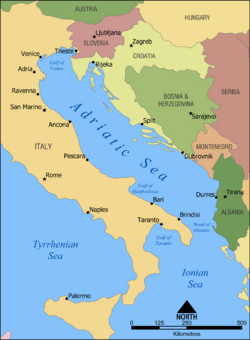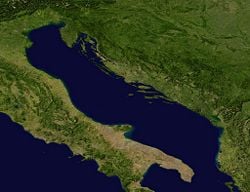Difference between revisions of "Adriatic Sea" - New World Encyclopedia
Mary Anglin (talk | contribs) m |
Mary Anglin (talk | contribs) |
||
| Line 1: | Line 1: | ||
{{Images OK}} | {{Images OK}} | ||
| − | |||
[[Image:Adriatic Sea map.png|thumb|right|250px|Map of the Adriatic Sea showing border nations.]] | [[Image:Adriatic Sea map.png|thumb|right|250px|Map of the Adriatic Sea showing border nations.]] | ||
| Line 9: | Line 8: | ||
==Name and etymology== | ==Name and etymology== | ||
| + | [[Image:Adriatic Sea.jpg|thumb|right|250px|A satellite image of the Adriatic Sea.]] | ||
The name has existed since antiquity; in the [[Latin]] of the [[Ancient Rome|Romans]] (Ancient Latin) it was ''Mare Superum''; in [[medieval Latin]] it was ''Mare Hadriaticum'' or ''Mare Adriaticum''. The name, derived from the [[Etruscan civilization|Etruscan]] colony of [[Adria]] (or ''Hadria''), originally designated only the upper portion of the sea <ref>Herodotus vi. 127, vii. 20, ix. 92; Euripides, ''Hippolytus,'' 736</ref>, but was gradually extended as the [[Syracuse, Italy|Syracusan]] colonies gained in importance. The word Adria probably derives from the [[Illyrian]] word ''adur'' meaning "water" or "sea". <ref> Room, Adrian. 1999. ''Brewer's dictionary of names''. Oxford: Helicon. ISBN 185986323X p.7. </ref> | The name has existed since antiquity; in the [[Latin]] of the [[Ancient Rome|Romans]] (Ancient Latin) it was ''Mare Superum''; in [[medieval Latin]] it was ''Mare Hadriaticum'' or ''Mare Adriaticum''. The name, derived from the [[Etruscan civilization|Etruscan]] colony of [[Adria]] (or ''Hadria''), originally designated only the upper portion of the sea <ref>Herodotus vi. 127, vii. 20, ix. 92; Euripides, ''Hippolytus,'' 736</ref>, but was gradually extended as the [[Syracuse, Italy|Syracusan]] colonies gained in importance. The word Adria probably derives from the [[Illyrian]] word ''adur'' meaning "water" or "sea". <ref> Room, Adrian. 1999. ''Brewer's dictionary of names''. Oxford: Helicon. ISBN 185986323X p.7. </ref> | ||
Revision as of 01:14, 5 October 2008
The Adriatic Sea is an arm of the Mediterranean Sea which separates the Italian Peninsula from the Balkan peninsula, and the system of the Apennine Mountains from that of the Dinaric Alps and adjacent ranges. It extends from the Gulf of Venice southward to the Strait of Otranto, which links it to the Ionian Sea. It has an approximate length of 500 miles (800 km), an average width of 100 miles, and an area of 50,590 sq mi (131,050 sq km).
The sea's western coast runs the length of Italy, while the eastern coast forms the borders of Croatia, Bosnia and Herzegovina, Montenegro and Albania. A small slice of Slovenia also reaches to the Sea. Major rivers joining the Adriatic are the Reno, Po, Adige, Brenta, Piave, Soča/Isonzo, Zrmanja, Krka, Cetina, Neretva, Drin (Drini).
Name and etymology
The name has existed since antiquity; in the Latin of the Romans (Ancient Latin) it was Mare Superum; in medieval Latin it was Mare Hadriaticum or Mare Adriaticum. The name, derived from the Etruscan colony of Adria (or Hadria), originally designated only the upper portion of the sea [1], but was gradually extended as the Syracusan colonies gained in importance. The word Adria probably derives from the Illyrian word adur meaning "water" or "sea". [2]
But even then the Adriatic in the narrower sense only extended as far as the Monte Gargano, the outer portion being called the Ionian Sea. The name was sometimes, however, inaccurately used to include the Gulf of Tarentum (the modern-day Gulf of Taranto), the Sea of Sicily, the Gulf of Corinth and even the sea between Crete and Malta[3].
The Adriatic Sea is situated largely between the eastern coast of Italy and the western coast of Croatia, both major tourist attractions. It was used by the ancient Romans to transport goods, including animals and slaves, to Ostia, the Roman port.
Extent and Bathymetry
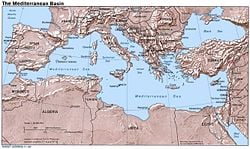
The Adriatic extends northwest from 40° to 45° 45' N., with an extreme length of about 770 km (415 nautical miles, 480 mi). It has a mean breadth of about 160 km (85 nautical miles, 100 mi), although the Strait of Otranto, through which it connects at the south with the Ionian Sea, is only 45-55 nautical miles wide (85-100 km).
The chain of islands which fringes the northern section of the eastern shore reduces the extreme breadth of open sea in this area to 145 km (78 nm, 90 mi). Its total surface area is about 60,000 square miles (160,000 km²).
The northern part of the sea is very shallow, and between the southern promontories of Istria and Rimini the depth rarely exceeds 46 m (25 fathoms). Between Šibenik and Ortona a well-marked depression occurs, a considerable area of which exceeds 180 m (100 fathoms) in depth.
From a point between Korčula and the north shore of the spur of Monte Gargano there is a ridge giving shallower water, and a broken chain of a few islets extends across the sea.
The deepest part of the sea lies east of Monte Gargano, south of Dubrovnik, and west of Durrës where a large basin gives depths of 900 m (500 fathoms) and upwards, and a small area in the south of this basin falls below 1,460 m (800 fathoms). The mean depth of the sea is estimated at 240 m (133 fathoms).
Coasts and islands
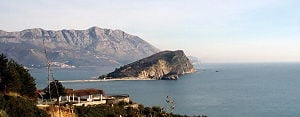
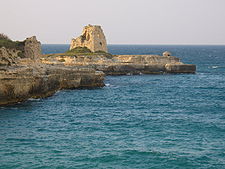
The east and west coasts of the Adriatic vary greatly. The west shore, along Italy, is relatively straight, continuous, and generally low, merging in the northwest, into the marshes and lagoons on either hand of the protruding delta of the River Po, the sediment of which has pushed forward the coastline for several miles within historic times — Adria is now some distance from the shore.
The east coast along the Balkan Peninsula is generally bold and rocky, with over one thousand islands varying in size. Numerous straits form inlets between the islands similar to those of the Norwegian fjords, forming an intricate coastline. South of the Istrian Peninsula, which separates the Gulfs of Venice and Gulf of Trieste from the Bay of Kvarner, the island-fringe of the east coast extends as far south as Dubrovnik.
The islands, which are long and narrow (the long axis lying parallel with the coast of the mainland), rise rather abruptly to elevations of a few hundred feet, with the exception of a few larger islands such as Brač (Vidova gora, 778 m) or the peninsula Pelješac (St. Ilija, 961 m). There are over a thousand islands in the Adriatic, 66 of which are inhabited. On the mainland, notably in the Gulf of Kotor (Boka Kotorska; named after the town of Kotor), lofty mountains often fall directly to the sea.
The prevalent color of the rocks is a light, dead grey, contrasting harshly with the dark vegetation, which on some of the islands is luxuriant. Attesting to this, Montenegro (Black Mountain) was named for the black pines that cover the coast there, and similarly the Greek name for the island of Korčula is Korkyra Melaina meaning "Black Corfu".
Notable cities on the Italian coast are Trieste, Ravenna, Rimini, Ancona, Pescara, Bari and Brindisi. The city of Venice stretches across numerous small islands in the marshy Venetian Lagoon, which stretches along the shoreline of the Adriatic in northeast Italy between the mouths of the Po (south) and the Piave (north) Rivers.
Major cities on the northeastern coast include Trieste in Italy; Koper in Slovenia; Umag, Poreč, Rovinj, Pula, Opatija, Rijeka, Senj, Zadar, Biograd, Šibenik, Trogir, Split, Makarska, Ploče and Dubrovnik in Croatia; Neum in Bosnia and Herzegovina; Herceg Novi, Kotor, Tivat, Bar, Budva and Ulcinj in Montenegro; and Durrës in Albania.
Weather patterns
There are eight basic winds prevalent in the Mediterranean region. Three of these are common to the Adriatic; the bora, the sirocco, and the maestro.
The bora (northeast wind), and the prevalence of sudden squalls from this quarter or the southeast, are dangers to navigation in winter. Also notable are sirocco (southern wind) which brings rain in the winter and maestral (western wind) which brings clear weather in the summer.
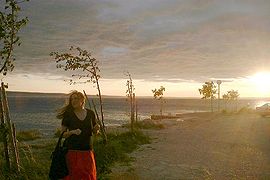
The Bora is a northern to north-eastern katabatic wind in the Adriatic, Croatia, Italy, Greece, and Turkey. Its name derives from the Greek mythological figure of Boreas, the North Wind. The changeable Bora often blows throughout Dalmatia and the Adriatic east coast. It is a gusty wind, most common during the winter season. The area where some of the strongest bora winds occur is the Velebit mountain range in Croatia. The wind is also an integral feature of Slovenia's Vipava Valley and Kras region, (the Carso in Italy), an area of limestone heights over the Trieste Bay stretching towards the Istrian peninsula. Because the region separates the lower Adriatic coast from the Julian Alps range, extreme bora winds often occur there. They have influenced the region's traditional lifestyle and architecture. Towns on the coast, where the Bora frequently occurs, are built densely with narrow streets in part because of the wind. Buildings in several towns and villages in Slovenia and the Province of Trieste (Italy) have stones on their roofs to prevent the roof tiles from being blown off.
Template:Mediterranean wind rose The Sirocco is a Mediterranean wind that comes from the Sahara and reaches hurricane speeds in North Africa and Southern Europe.
The sirocco reaching the south of France contains more moisture and is known as the marin. In the Canary Islands this oppressive, hot, dust bearing wind is called La Kalima. The name of sirocco in the southwest of Spain is leveche, and xaloc in Catalan. The leveche usually carries red Sahara dust and is associated with storms and heavy rain, the wind being very strong, lasting about 4 days. In Malta, it is known as xlokk. [4]
It arises from a warm, dry, tropical airmass that is pulled northward by low-pressure cells moving eastward across the Mediterranean Sea, with the wind originating in the Arabian or Sahara deserts.[5] The hotter, drier continental air mixes with the cooler, wetter air of the maritime cyclone, and the counter-clockwise circulation of the low propels the mixed air across the southern coasts of Europe.
The Sirocco causes dusty, dry conditions along the northern coast of Africa, storms in the Mediterranean Sea, and cold, wet weather in Europe. The Sirocco's duration may be a half day or many days. Many people attribute health problems to the Sirocco either because of the heat and dust along the African coastal regions or the cool dampness in Europe. The dust within the Sirocco winds can degrade mechanical devices and invade domiciles.
These winds with speeds of almost 100 kilometres per hour are most common during the autumn and the spring. They reach a peak in March and in November, with a maximum speed of about 100 km/h (55 knots).
Other prominent wind systems in the region are the bora/bura/burja (northwestern) and the llebeig/lebeccio/lebić (southwestern).
Maestro or maestral is a northwesterly wind which blows in summer in the Adriatic when pressure is low over the Balkan peninsula. It is a fresh breeze accompanied by fine weather and light clouds. It is not to be confused with mistral, a quite different (although also northwesterly) wind in southern France.
The maestro is the most favoured summer wind as far south as western Crete where it supposedly blows only during daytime.
Notes
- ↑ Herodotus vi. 127, vii. 20, ix. 92; Euripides, Hippolytus, 736
- ↑ Room, Adrian. 1999. Brewer's dictionary of names. Oxford: Helicon. ISBN 185986323X p.7.
- ↑ The Book of Acts - 27:27
- ↑ Encyclopaedia Britannica. Scirocco/xlokk Retrieved on 2007-05-19.
- ↑ Golden Gate Weather Services. Names of Winds. Retrieved on 2006-12-28.
ReferencesISBN links support NWE through referral fees
- 1yachtua.com. Local Mediterranean winds Retrieved October 5, 2008.
- Croatian National Tourist Board. Adriatic Sea Retrieved October 2, 2008.
- Denham, H. M. 1967. The Adriatic: A Sea-guide to its Coasts and Islands. London: Murray.
- Find Croatia. Adriatic Sea Retrieved October 2, 2008.
- Golden Gate Weather Services. Name of Winds Retrieved October 5, 2008.
- McKinney, Frank K. 2007. The Northern Adriatic Ecosystem: Deep Time in a Shallow Sea. New York: Columbia University Press. ISBN 0231132425
External links
- Satellite images and maps of Adriatic Sea. GeaBios. GIS Public Service. Retrieved December 12, 2007.
- Weather forecast for eastern coast. GeaBios. GIS Public Service. Retrieved December 12, 2007.
Credits
New World Encyclopedia writers and editors rewrote and completed the Wikipedia article in accordance with New World Encyclopedia standards. This article abides by terms of the Creative Commons CC-by-sa 3.0 License (CC-by-sa), which may be used and disseminated with proper attribution. Credit is due under the terms of this license that can reference both the New World Encyclopedia contributors and the selfless volunteer contributors of the Wikimedia Foundation. To cite this article click here for a list of acceptable citing formats.The history of earlier contributions by wikipedians is accessible to researchers here:
The history of this article since it was imported to New World Encyclopedia:
Note: Some restrictions may apply to use of individual images which are separately licensed.
